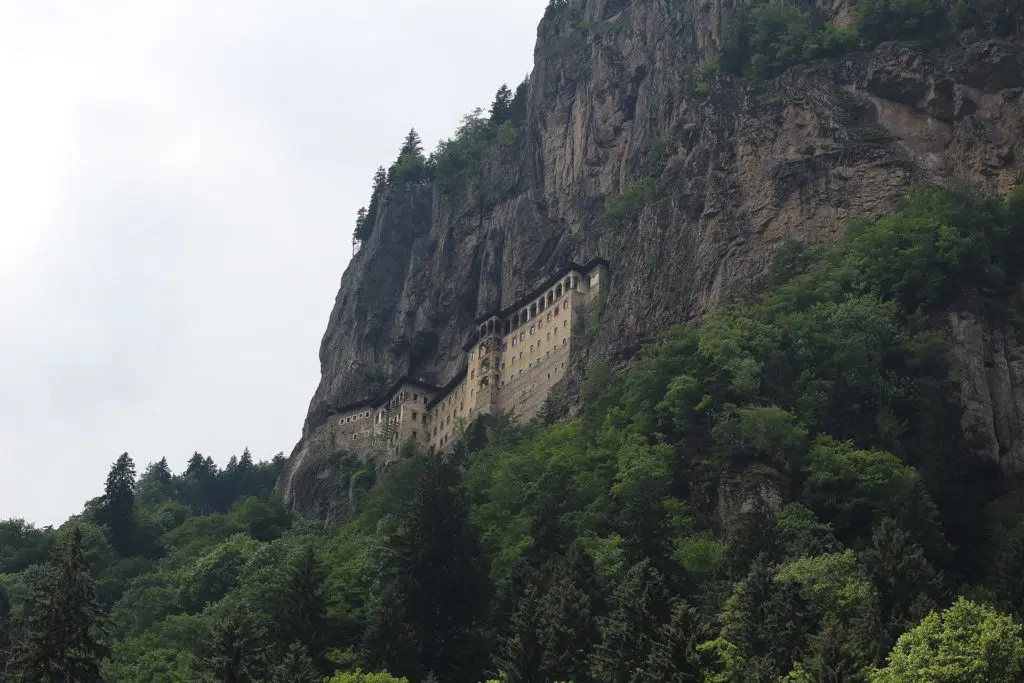
The courtyard of Panagia Soumela Monastery was recently turned into a nightclub for an advertising video clip, causing outrage in the Orthodox world.
The iconic Greek Orthodox monastery in Trabzon, Turkey is a tourist attraction where each year on August 15 the service for the Dormition of the Virgin Mary is held by the Ecumenical Patriarch.
The controversial video clip, with a DJ playing loud electronic music in the courtyard of the historic monastery and people dancing, had many Orthodox Christians reacting in anger.
Many comments in social media speak of the desecration of the historic monastery as along with the music, church bells can be heard in the background.
Some even demanded explanations from Turkish authorities, as the historic monastery had essentially been turned into a nightclub.
According to the makers of the video clip, the video was shot in order to promote Panagia Soumela as a tourist attraction, with permission to do so granted by Turkish authorities.
The story of the Panagia Soumela holy icon
The miraculous holy icon of Panagia Soumela was created by St. Luke the Evangelist, according to Orthodox Church tradition.
The word’s etymology, Soumela, comes from Mount mela and the Pontic idiom “sou” which means “in the” or “in him”, and therefore “in the Mela”, which eventually became Soumela.
After the death of the Apostle and Evangelist, his student Ananias brought the icon that St. Luke had painted to Athens and placed it in the beautiful church of the Virgin Mary. At that time the icon was called Panagia Athiniotissa (the Athenian).
According to Orthodox tradition, the Athenian monks Barnabas and Sophronios, responding to the call of the Virgin Mary, followed the path of the icon which led them to Pontus.
The two monks crossed Meteora, Halkidiki and the beach near the Vatopedi Monastery, from which an unknown man transported them by boat to Maronia.
Barnabas and Sophronios crossed Redestos on foot and finally managed to reach Constantinople, from which they traveled to Trabzon by boat.
There, the Virgin Mary appeared to the two Athenian monks to inform them that her icon was traveling toward Mount Mela.
The icon at Mount Mela
Using the Pyxitis River as their compass, and inspired by the power of their faith, they ascended to the mountain, until the moment they found themselves in front of the entrance of a cave from which a golden glow was emanating.
This glow was none other than the light of the Icon of Panagia Athiniotissa.
Barnabas and Sophronios knelt on the ground and cried tears of joy, thanking the Virgin Mary and promising to build a temple in her honor at that very spot.
With faith, perseverance and hard work, the two determined monks managed to build a church carved into the cave on the steep slopes of Mount Mela, at an altitude of 1,063 meters (3,487 feet) in the year 386 AD.
Since then the icon has become known as Panagia Soumela, while the famous Orthodox monastery near Trabzon has remained the symbol of Pontian Hellenism for sixteen centuries.
See all the latest news from Greece and the world at Greekreporter.com. Contact our newsroom to report an update or send your story, photos and videos. Follow GR on Google News and subscribe here to our daily email!



